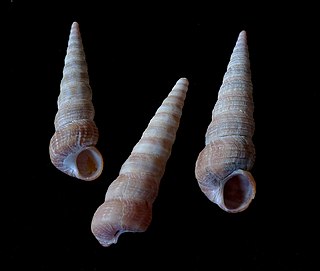
A siphon is an anatomical structure which is part of the body of aquatic molluscs in three classes: Gastropoda, Bivalvia and Cephalopoda.

The aperture is an opening in certain kinds of mollusc shells: it is the main opening of the shell, where the head-foot part of the body of the animal emerges for locomotion, feeding, etc.

A spire is a part of the coiled shell of molluscs. The spire consists of all of the whorls except for the body whorl. Each spire whorl represents a rotation of 360°. A spire is part of the shell of a snail, a gastropod mollusc, a gastropod shell, and also the whorls of the shell in ammonites, which are fossil shelled cephalopods.

The operculum is a corneous or calcareous anatomical structure like a trapdoor that exists in many groups of sea snails and freshwater snails, and also in a few groups of land snails; the structure is found in some marine and freshwater gastropods, and in a minority of terrestrial gastropods, including the families Helicinidae, Cyclophoridae, Aciculidae, Maizaniidae, Pomatiidae, etc.

The gastropod shell is part of the body of a gastropod or snail, a kind of mollusc. The shell is an exoskeleton, which protects from predators, mechanical damage, and dehydration, but also serves for muscle attachment and calcium storage. Some gastropods appear shell-less (slugs) but may have a remnant within the mantle, or the shell is reduced such that the body cannot be retracted within (semi-slug). Some snails also possess an operculum that seals the opening of the shell, known as the aperture, which provides further protection. The study of mollusc shells is known as conchology. The biological study of gastropods, and other molluscs in general, is malacology. Shell morphology terms vary by species group.
The clausilium is a calcareous anatomical structure which is found in one group of air-breathing land snails: terrestrial pulmonate gastropod mollusks in the family Clausiliidae, the door snails. The clausilium is one part of the clausilial apparatus.

Melo melo, common name the Indian volute or bailer shell, is a very large sea snail, a marine gastropod mollusc in the family Volutidae, the volutes.

Lentigo lentiginosus, common name the silver conch, is a species of medium-sized sea snail, a marine gastropod mollusk in the family Strombidae, the true conchs.

Laevistrombus canarium is a species of edible sea snail, a marine gastropod mollusc in the family Strombidae. Known from illustrations in books dating from the late 17th century, L. canarium is an Indo-Pacific species occurring from India and Sri Lanka to Melanesia, Australia and southern Japan. The shell of adult individuals is coloured from light yellowish-brown to golden to grey. It has a characteristic inflated body whorl, a flared, thick outer lip, and a shallow stromboid notch. The shell is valued as an ornament, and because it is heavy and compact, it is also often used as a sinker for fishing nets.
The following is a glossary of common English language and scientific terms used in the description of gastropods.
Pleurotomella dinora is a species of sea snail, a marine gastropod mollusk in the family Raphitomidae.

Spergo glandiniformis is a species of sea snail, a marine gastropod mollusk in the family Raphitomidae.

Thesbia nana is a species of sea snail, a marine gastropod mollusk in the family Raphitomidae.

Solariella charopa is a species of sea snail, a marine gastropod mollusk in the family Solariellidae.

Isara gabonensis is a species of sea snail, a marine gastropod mollusk in the family Mitridae, the miters or miter snails.

Potamolithus rushii is a species of freshwater snail with an operculum, an aquatic gastropod mollusk in the family Lithoglyphidae.

Calliostoma stirophorum is a species of sea snail, a marine gastropod mollusk in the family Calliostomatidae.

Nassarius fossatus, the channeled basket snail, is a species of sea snail, a marine gastropod mollusc in the family Nassariidae, the nassa mud snails or dog whelks. It is native to the west coast of North America where it is found on mudflats on the foreshore and on sand and mud in shallow water.
This outline is provided as an overview of, and organized list of articles relevant to, the subject of gastropods :

Azorilla lottae is a species of sea snail, a marine gastropod mollusk in the family Raphitomidae.

















